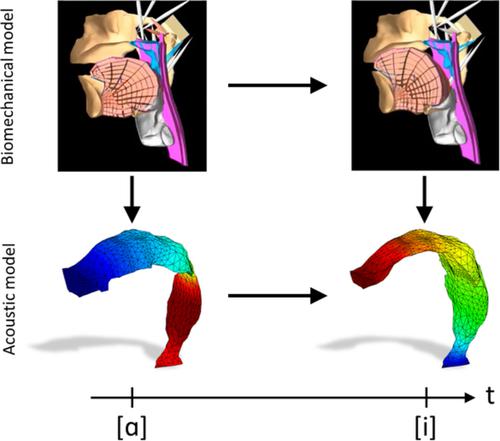当前位置:
X-MOL 学术
›
Int. J. Numer. Method. Biomed. Eng.
›
论文详情
Our official English website, www.x-mol.net, welcomes your
feedback! (Note: you will need to create a separate account there.)
Simulation of vowel‐vowel utterances using a 3D biomechanical‐acoustic model
International Journal for Numerical Methods in Biomedical Engineering ( IF 2.2 ) Pub Date : 2020-10-17 , DOI: 10.1002/cnm.3407 Saeed Dabbaghchian 1 , Marc Arnela 2 , Olov Engwall 1 , Oriol Guasch 2
International Journal for Numerical Methods in Biomedical Engineering ( IF 2.2 ) Pub Date : 2020-10-17 , DOI: 10.1002/cnm.3407 Saeed Dabbaghchian 1 , Marc Arnela 2 , Olov Engwall 1 , Oriol Guasch 2
Affiliation

|
A link is established between biomechanical and acoustic 3D models for the numerical simulation of vowel‐vowel utterances. The former rely on the activation and contraction of relevant muscles for voice production, which displace and distort speech organs. However, biomechanical models do not provide a closed computational domain of the 3D vocal tract airway where to simulate sound wave propagation. An algorithm is thus proposed to extract the vocal tract boundary from the surrounding anatomical structures at each time step of the transition between vowels. The resulting 3D geometries are fed into a 3D finite element acoustic model that solves the mixed wave equation for the acoustic pressure and particle velocity. An arbitrary Lagrangian–Eulerian framework is considered to account for the evolving vocal tract. Examples include six static vowels and three dynamic vowel‐vowel utterances. Plausible muscle activation patterns are first determined for the static vowel sounds following an inverse method. Dynamic utterances are then generated by linearly interpolating the muscle activation of the static vowels. Results exhibit nonlinear trajectory of the vocal tract geometry, similar to that observed in electromagnetic midsagittal articulography. Clear differences are appreciated when comparing the generated sound with that obtained from direct linear interpolation of the vocal tract geometry. That is, interpolation between the starting and ending vocal tract geometries of an utterance, without resorting to any biomechanical model.
中文翻译:

使用 3D 生物力学-声学模型模拟元音-元音发音
在生物力学和声学 3D 模型之间建立了联系,用于元音-元音发音的数值模拟。前者依靠相关肌肉的激活和收缩来产生声音,从而使发音器官移位和扭曲。然而,生物力学模型不提供用于模拟声波传播的 3D 声道气道的封闭计算域。因此提出了一种算法来在元音之间转换的每个时间步从周围的解剖结构中提取声道边界。生成的 3D 几何形状被输入到 3D 有限元声学模型中,该模型求解声压和粒子速度的混合波动方程。任意的拉格朗日-欧拉框架被认为可以解释不断变化的声道。示例包括六个静态元音和三个动态元音元音发音。首先按照逆方法为静态元音确定合理的肌肉激活模式。然后通过线性插入静态元音的肌肉激活来生成动态话语。结果显示声道几何的非线性轨迹,类似于在电磁正中矢状关节造影中观察到的轨迹。当将生成的声音与从声道几何结构的直接线性插值中获得的声音进行比较时,会发现明显的差异。也就是说,在不借助任何生物力学模型的情况下,在话语的开始和结束声道几何形状之间进行插值。首先按照逆方法为静态元音确定合理的肌肉激活模式。然后通过线性插入静态元音的肌肉激活来生成动态话语。结果显示声道几何的非线性轨迹,类似于在电磁正中矢状关节造影中观察到的轨迹。当将生成的声音与从声道几何结构的直接线性插值中获得的声音进行比较时,会发现明显的差异。也就是说,在不借助任何生物力学模型的情况下,在话语的开始和结束声道几何形状之间进行插值。首先按照逆方法为静态元音确定合理的肌肉激活模式。然后通过线性插入静态元音的肌肉激活来生成动态话语。结果显示声道几何的非线性轨迹,类似于在电磁正中矢状关节造影中观察到的轨迹。当将生成的声音与从声道几何结构的直接线性插值中获得的声音进行比较时,会发现明显的差异。也就是说,在不借助任何生物力学模型的情况下,在话语的开始和结束声道几何形状之间进行插值。类似于在电磁正中矢状关节造影中观察到的。当将生成的声音与从声道几何结构的直接线性插值中获得的声音进行比较时,会发现明显的差异。也就是说,在不借助任何生物力学模型的情况下,在话语的开始和结束声道几何形状之间进行插值。类似于在电磁正中矢状关节造影中观察到的。当将生成的声音与从声道几何结构的直接线性插值中获得的声音进行比较时,会发现明显的差异。也就是说,在不借助任何生物力学模型的情况下,在话语的开始和结束声道几何形状之间进行插值。
更新日期:2020-10-17
中文翻译:

使用 3D 生物力学-声学模型模拟元音-元音发音
在生物力学和声学 3D 模型之间建立了联系,用于元音-元音发音的数值模拟。前者依靠相关肌肉的激活和收缩来产生声音,从而使发音器官移位和扭曲。然而,生物力学模型不提供用于模拟声波传播的 3D 声道气道的封闭计算域。因此提出了一种算法来在元音之间转换的每个时间步从周围的解剖结构中提取声道边界。生成的 3D 几何形状被输入到 3D 有限元声学模型中,该模型求解声压和粒子速度的混合波动方程。任意的拉格朗日-欧拉框架被认为可以解释不断变化的声道。示例包括六个静态元音和三个动态元音元音发音。首先按照逆方法为静态元音确定合理的肌肉激活模式。然后通过线性插入静态元音的肌肉激活来生成动态话语。结果显示声道几何的非线性轨迹,类似于在电磁正中矢状关节造影中观察到的轨迹。当将生成的声音与从声道几何结构的直接线性插值中获得的声音进行比较时,会发现明显的差异。也就是说,在不借助任何生物力学模型的情况下,在话语的开始和结束声道几何形状之间进行插值。首先按照逆方法为静态元音确定合理的肌肉激活模式。然后通过线性插入静态元音的肌肉激活来生成动态话语。结果显示声道几何的非线性轨迹,类似于在电磁正中矢状关节造影中观察到的轨迹。当将生成的声音与从声道几何结构的直接线性插值中获得的声音进行比较时,会发现明显的差异。也就是说,在不借助任何生物力学模型的情况下,在话语的开始和结束声道几何形状之间进行插值。首先按照逆方法为静态元音确定合理的肌肉激活模式。然后通过线性插入静态元音的肌肉激活来生成动态话语。结果显示声道几何的非线性轨迹,类似于在电磁正中矢状关节造影中观察到的轨迹。当将生成的声音与从声道几何结构的直接线性插值中获得的声音进行比较时,会发现明显的差异。也就是说,在不借助任何生物力学模型的情况下,在话语的开始和结束声道几何形状之间进行插值。类似于在电磁正中矢状关节造影中观察到的。当将生成的声音与从声道几何结构的直接线性插值中获得的声音进行比较时,会发现明显的差异。也就是说,在不借助任何生物力学模型的情况下,在话语的开始和结束声道几何形状之间进行插值。类似于在电磁正中矢状关节造影中观察到的。当将生成的声音与从声道几何结构的直接线性插值中获得的声音进行比较时,会发现明显的差异。也就是说,在不借助任何生物力学模型的情况下,在话语的开始和结束声道几何形状之间进行插值。











































 京公网安备 11010802027423号
京公网安备 11010802027423号